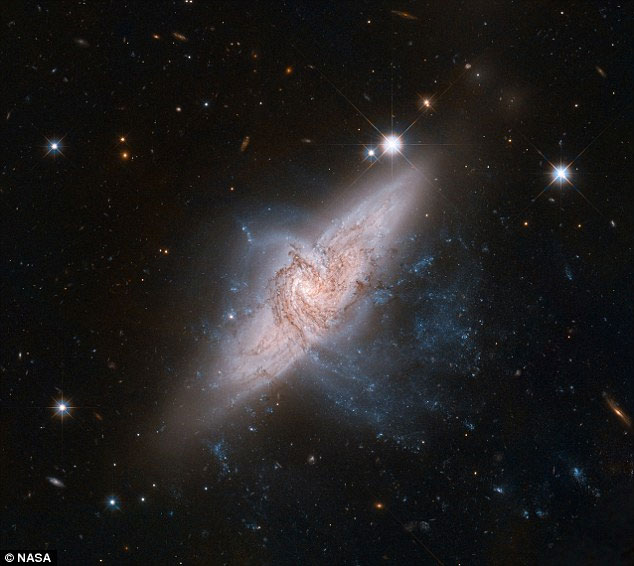Unique picture of 2 galaxies colliding
Performing the task of studying the phenomenon of light amplification when two galaxies lie in the same line, NASA's Hubble Space Telescope accidentally captured the images of two galaxies NGC 3314A and NGC 3314B, away from Earth respectively 117 million and 140 million years of light, seemingly colliding.
>>>New candidate for the "oldest galaxy" throne
However, scientists claim there is no need to panic because this is simply because of the Hubble telescope's angle. In fact, they are tens of millions of light years apart and both galaxies never collide.
According to Dailymail, to know if these two galaxies really collide or not, the most convincing evidence is to see the shapes of these two galaxies. Terrible gravitational force when two galaxies close together will cause the galaxy to deform before they actually collide.

Thanks to exposure for more than an hour, the picture is not just for
see galaxy pair NGC 3314 but there are many distant galaxies in the background.
Distorting a galaxy not only changes its structure but also promotes the process of new star formation, which we can see its blue light. Studying the motion of these two galaxies shows that both are very quiet and move independently.
However, the photograph of NGC 3314 shows that there appears to be distortion in the galaxy NGC 3314A in the front, (NGC 3314B is behind), but it is not so.
The distorted shape of the galaxy NGC 3314A, especially in its lower and right center, where blue, white stars burst out of the galaxy's spiral arms, not by colliding with galaxy NGC 3314B behind that may be due to interaction with another galaxy, perhaps the nearby NGC 3312 galaxy.
Both galaxies are located in the same line so the dust of NGC 3314B looks much brighter than the galaxy NGC 3314A because it is illuminated by forward stars while the galaxy NGC 3314A is backlit. look darker.
It is very rare for two galaxies to lie on the same straight line, so when this phenomenon occurs, astronomers have not missed the opportunity to study the phenomenon of gravitational amplification. This is a phenomenon where stars in a galaxy make light come from a galaxy far away from it, which is slightly disturbed.
- Clash between two galaxies
- NASA takes a picture of two colliding galaxies
- Observing the scene where two galaxies collide creates black holes
- 'The cosmic eye' emerged from the clash between the two galaxies
- Hubble's beautiful picture of galaxy collisions
- Decoding adds a mystery of the universe
- Two galaxies collide, producing a series of strange stars
- The chaos and strange duo of galaxies
- Two collision galaxies are 424 million light-years from Earth
- Detecting the monstrous galaxy UGC 1382 in space
- Detecting exotic galaxies, about 359 million light-years from Earth
- The mystery of the dead galaxies
 Van Allen's belt and evidence that the Apollo 11 mission to the Moon was myth
Van Allen's belt and evidence that the Apollo 11 mission to the Moon was myth The levels of civilization in the universe (Kardashev scale)
The levels of civilization in the universe (Kardashev scale) Today Mars, the sun and the Earth are aligned
Today Mars, the sun and the Earth are aligned The Amazon owner announced a secret plan to build a space base for thousands of people
The Amazon owner announced a secret plan to build a space base for thousands of people